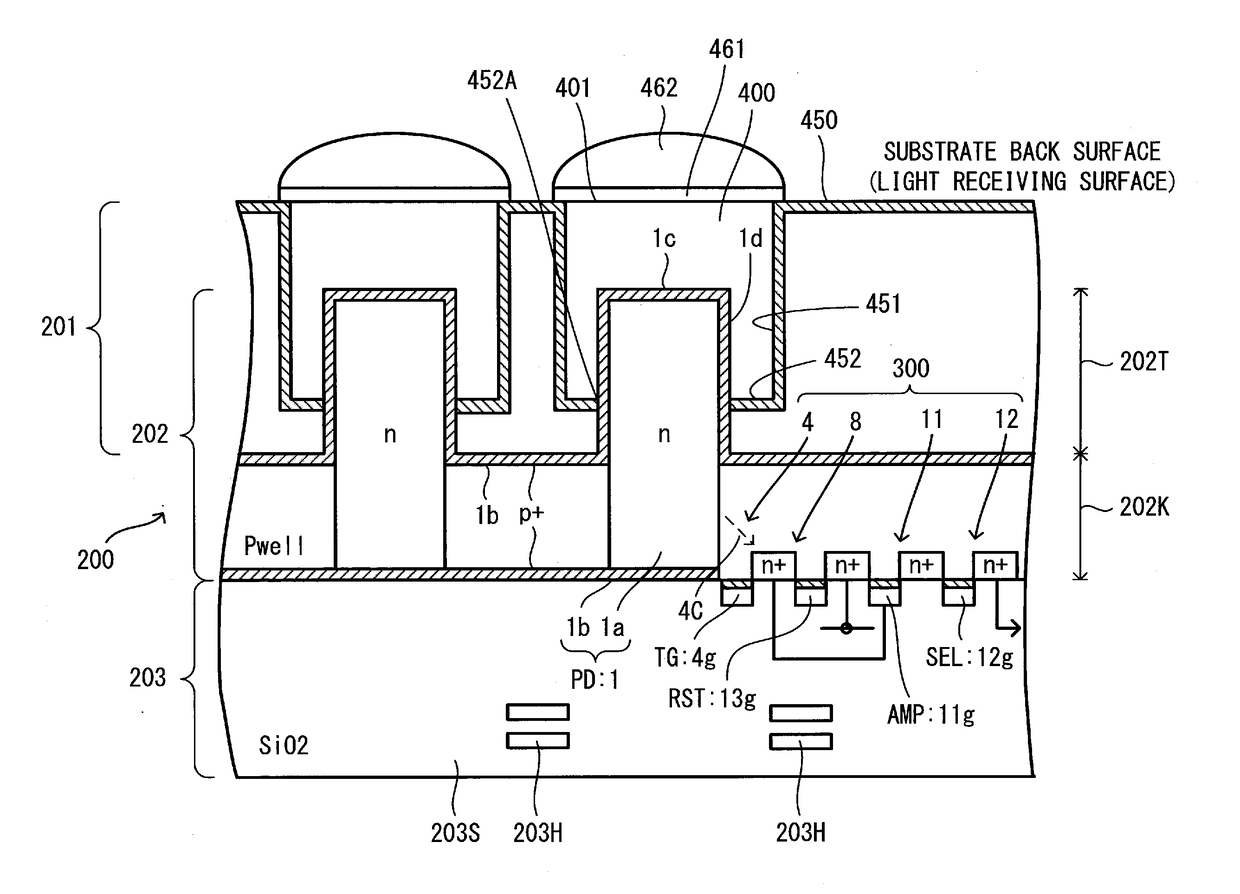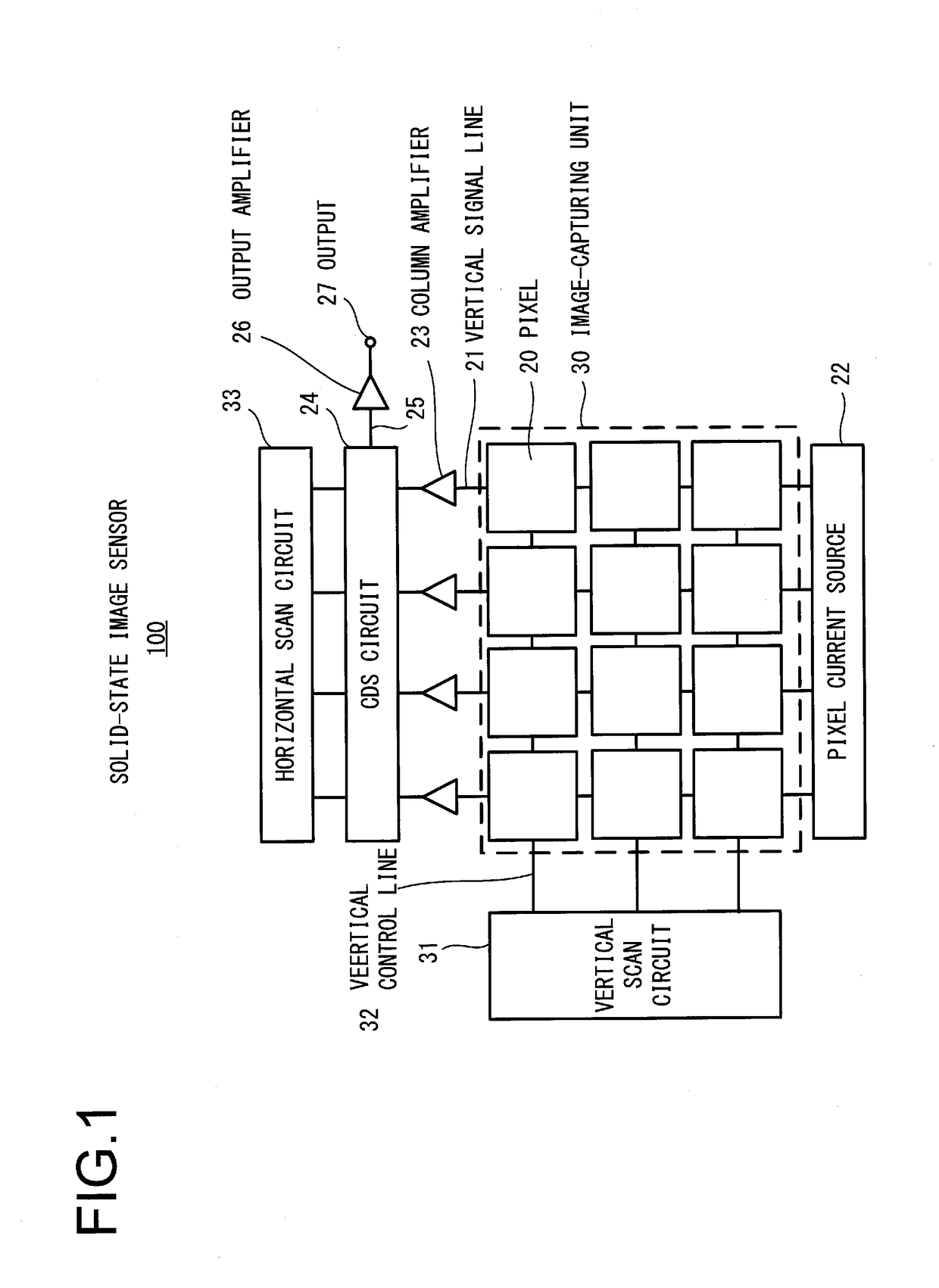Image sensor and image-capturing device
- Summary
- Abstract
- Description
- Claims
- Application Information
AI Technical Summary
Benefits of technology
Problems solved by technology
Method used
Image
Examples
first embodiment
[0030]Schematic Element Structure
[0031]FIG. 1 is a view illustrating a schematic configuration of a solid-state image sensor 100 according to a first embodiment.
[0032]The solid-state image sensor 100 includes an image-capturing unit 30 having pixels 20 arranged on a light receiving surface. The pixels 20 are supplied with drive pulses from a vertical scan circuit 31 via vertical control lines 32. Further, the pixels 20 are connected to vertical signal lines 21 on a column basis. The vertical signal lines 21 are connected to a pixel current source 22.
[0033]Furthermore, noise outputs and signal outputs that are time-divisionally outputted from the pixels 20 to the vertical signal lines 21 are sequentially inputted to a CDS circuit (a correlated double sampling circuit) 24 via column amplifiers 23. The CDS circuit 24 calculates a difference between both outputs to generate a true signal output. This true signal output is horizontally scanned by a drive signal from a horizontal scan cir...
second embodiment
Third Variation of Second Embodiment
[0148]FIG. 13 is a view illustrating a configuration of a solid-state image sensor 100D according to a third variation of the second embodiment, and it corresponds to FIG. 7 for the second embodiment. An equivalent circuit of the solid-state image sensor 100D in FIG. 13 is illustrated in FIG. 12. The same parts as those in FIGS. 7 and 4(b) are denoted by the same reference signs, and differences will be mainly described.
[0149]In the solid-state image sensor 100A in FIG. 6, the FD 8 is connected to the back gate electrode of the amplification transistor 11 without wiring, and the predetermined potential (e.g., the reference potential Vdd) is applied to the top gate electrode 11g. Contrastingly, in the solid-state image sensor 100D in FIG. 13, the top gate electrode of the amplification transistor 11 is connected to the FD 8 without wiring, and the back gate electrode of the amplification transistor 11 directly connects the GND terminal to the p reg...
fourth embodiment
[0158]FIG. 15 is a view illustrating a configuration of a solid-state image sensor 100F according to a fourth embodiment, and it corresponds to FIG. 14 for the third embodiment. The same parts as those in FIG. 14 are denoted by the same reference signs, and differences will be mainly described.
[0159]The solid-state image sensor 100E according to the third embodiment is a so-called back illumination type element. The solid-state image sensor 100F according to the fourth embodiment is a front illumination type element in which a wiring region is arranged on the light receiving surface side. The wiring 203H is formed in a region further outside of the optical path region 400, that is, the oxide film 201 on the light receiving surface side. Other parts of the configuration are the same as those in the third embodiment and an explanation thereof will thus be omitted.
[0160]The solid-state image sensor 100F according to the fourth embodiment can also achieve similar advantageous effects as...
PUM
 Login to View More
Login to View More Abstract
Description
Claims
Application Information
 Login to View More
Login to View More - R&D
- Intellectual Property
- Life Sciences
- Materials
- Tech Scout
- Unparalleled Data Quality
- Higher Quality Content
- 60% Fewer Hallucinations
Browse by: Latest US Patents, China's latest patents, Technical Efficacy Thesaurus, Application Domain, Technology Topic, Popular Technical Reports.
© 2025 PatSnap. All rights reserved.Legal|Privacy policy|Modern Slavery Act Transparency Statement|Sitemap|About US| Contact US: help@patsnap.com



